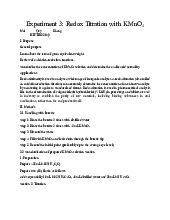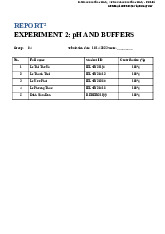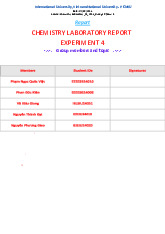









































































Preview text:
Analytical Chemistry 1 Lecture'10' Electrochemistry-and-Redox- titration- Instructor:'Nguyen'ThaoTrang Outlines
• Introduction.to.Electrochemistry
• Applications.of.Standard.electrode.potentials thế điện cực • Redox.titration 2 Outlines
• Introduction.to.Electrochemistry
• Applications.of.Standard.electrode.potentials • Redox.titration 3
Basic.concepts.of.electrochemistry
• Redox.reaction.:.reactions.with.electron.transfer
– oxidized.:.loses. electrons – reduced.:.gains.electrons
– oxidizing.agent.(oxidant).:.takes.electrons.from.others. and.becomes. reduced
– reducing.agent.(reductant). :.gives.electrons. to.another.substance.and. is.oxidized – Example
Fe3+.is.an.oxidizing.agent.as:.Fe3++.e- à Fe2+
V2+.is.an.reducing.agent.as:.V2+ à V3++.e- 4
Basic.concepts.of.electrochemistry • Redox.reaction.:
– Half.reactions:. A.common.approach.for.listing.species.that.undergo.
REDOX.is.by.using.half.reactions. oxidixing agent
Reduction:.Fe3++.e- à Fe2+ reducing agent half rxn (reduction rxn) Oxidation:.V2+ à V3+ - +.e half rxn (oxidation rxn)
à Redox.reaction.is.the.product.of.two.half.reactions
– Each.half.reaction.is.associated.with.a.standard.reduction.potential,. Eo’ Box+.e- → Bred,.Eo’ Ared → Aox+.e-,.Eo’ 5
Basic.concepts.of.electrochemistry • Redox.reaction.:
– Listed.half.reactions.with.standard.reduction.potential: 6
Basic.concepts.of.electrochemistry • Redox.reaction.:
– Example:.Determine.the.balanced.equation.for.the.reaction.of.Fe2+ with.Cr 2- 2O7 in.an.acidic.solution. – Solution: E 0
Cr2O7(2-)/Cr(3+)>E Fe(3+)/Fe(2+)=> Cr2O7 2-gains e more easily than Fe3+
• From.the.standard.reduction.potentials,.we.can.get: Fe3++.e- =.Fe2+ Eo= 0.77 Cr 2- 3+ 2O7 +.14H+ +.6e- =.2Cr +.7H2O Eo= 1.33
• We.know.that.one.of.the.half.reactions.must.be.reversed.since. oxidation.
and.reduction.reactions.must.both.occur
• Based.on.the.question,.Fe2+.must.undergo.oxidation.reaction: Fe2+ ez lose its e
à reverse.reaction.(1):.Fe2+.=.Fe3+ - +.e
– To.balance. the.equation,. the.number.of.electrons. in.both.equation. must.be.
the.same.à multiply.(1.).by.6:
6.x.(1):.....................6Fe2+.=.6Fe3++.6e- +.(2):..Cr 2- + - 3+ 2O7 +.14H +.6e =.2Cr +.7H2O. 6Fe2+.+.Cr2O 2- 7 +.14H+ =.6Fe3++.2Cr3++.7H2O. 7
Basic.concepts.of.electrochemistry • Electric.charge.q:.
– Is.measured.in.[coulomb].or.[C]
– Magnitude.of.the.charge.of.a.single.electron.=.1.602.x.10-19C.
– A.mole.of.electrons.has.a.charge.of.(1.602.x.10-19C)x.(6.022.x 1023
mol-1).=.9.649.x.104 C/mol,.which.is.called.the.Faraday'constant'(F).
– Relationship.between. charge.and.moles:
where.n'is.the.number.moles.of.electrons.transferred. 8
Basic.concepts.of.electrochemistry • Electric.charge.q:. 9
Basic.concepts.of.electrochemistry • Electric.current:
– The.quantity.of.charge.flowing.each.second.through.a.circuit.is.called. the.current.-
– The.unit.of.current.is.the.ampere,-abbreviated.A.
– A.current.of.1.A..represents.a.charge.of.1.C.per.second.flowing.past.a. point.in.a.circuit.
FIGURE-13-1-Electrons.flowing.into.a.
coil.of.Ptwire.at.which.Sn4+.ions.in. solution.are.reduced.to.Sn2+ . 10
Basic.concepts.of.electrochemistry
• Voltage,.work,.free.energy:
– Difference.in.electric'potential,.E.(measured.by.volt).between.two.
points.is.the.work.needed.when.moving.an.electric.charge.from.one. point.to.the.other: – Work:..Energy.in.joules • one.joule.of.energy.= .between.points.
whose.potential.differ.by.one.volt.
– Example:.How.much.work.is.required.to.move.2.36.mmolof.electrons.
through.a.potential.difference.of.1.05.V.? 2.39 x 102 J –
Work.done.on.surroundings..=.- ΔG 11
à ΔG.=.-E.q =.- nEF < 0=> E>0 => Del E (potential diff) >0
Basic.concepts.of.electrochemistry
• Types.of.electrochemical.cell: 1. Galvanic-cell-(Voltaic):-
A.cell.generates.electrical.energy.from.a.spontaneous. chemical.reaction. 2. Electrolytic-cell:
Is.where.non-spontaneous.redox.reactions.can.be.made.to.
occur.by.the.addition.of.electrical.energy.(process.is.termed. electrolysis). 12
Basic.concepts.of.electrochemistry
• Common.components.of.a.electrochemical.cell
– Electrodes:.conduct.electricity.between.cell.and. surroundings • Anode:.oxidation.occurs. • Cathode:.reduction.occurs.
– Electrolytes:.mixture.of.ions.involved.in.reaction.or. carrying.charge
– Salt.bridge:.completes.circuit.(provides.charge.balance) 13
Basic.concepts.of.electrochemistry • Galvanic.cell:
– A.simple.Galvanic.cell:.2.electrodes.in.a.solution.of.CdCl2:
One.electrode.is.cadmium;.the.other.is.metallic.silver. coated.with.solid.AgCl.E 0
AgCl/Ag>E Cd(2+)/Cd=> reverse the rxn at the anode
Anode:..... Cd.(s).↔ Cd2+(aq) +.2e-Eo= - 0.44
Cathode:...2AgCl.(s).+.2e- ↔ 2Ag(s).+.2Cl-(aq).
Cd.(s).+.2AgCl.(s).↔ Cd2+(aq) +.2Ag(s).+.2Cl-(aq) ΔG.=.-150.kJ/molCd
à Oxidation.of.Cd.electrode.provides.
electrons. that.flow.through.the.circuit.to. the.Ag.electrode.
AgCl(s)+e- ↔ Ag(s)+Cl-(aq) E0= 0.22 14
Basic.concepts.of.electrochemistry • Galvanic.cell:
– A.simple.Galvanic.cell:.2.electrodes.Cd.and.Ag.in.a.solution. of.Cd(NO3)2 and.AgNO3.: Not.really. work!
A.little.current.flows.through.the.circuit.as.Ag.
can.react.at.the.Cd.electrode..
the rxn still occur but no flow e e bị grap bởi Ag+ and NO3- 15
Basic.concepts.of.electrochemistry
• Galvanic.cell:.separation.of.two.half.reactions.by.the. use.of.a.salt.bridge
Porous.glass.disks.that.allow.ions.
to.diffuse.but.minimize.mixing.of.
solutions.inside.and.outside.the. bridge.
Ions.migrate.in.and.out.to.offset. the.charge.buildup 16
Basic.concepts.of.electrochemistry
• Cell.notation:.line.diagram.is.used.to.describe. electrochemical.cells 17 Standard.reduction.potential
• Standard.reduction.potential,.Eo’.for.each.half.is.measured.
using.the.standard.hydrogen.electrode.(S.H.E.)
• Example:. Ag+(aq).+.e- ↔ Ag.(s);.Eo’=0.799.V
à Set.the.potential.of.the.S.H.E.at.25oC.=.0
à A.standard.reduction.potential.is.really.a.potential.difference'between.the.
potential.of.the.reaction.of.interest.and.the.potential.of.S.H.E.(set.to.0) 18 Standard.reduction.potential
• A.positive.standard.reduction.potential.means.electron.flows. from.the.S.H.E..
– Example:. Ag+(aq).+.e- ↔ Ag.(s);.Eo’=0.799.V.:.e- flow.from.the.Pt electrode.to.the.Ag.electrode
• A.negative.standard.reduction.potential.means.electron.flows. to.the.S.H.E..
– Example:.Cd2+(aq).+.2e- ↔ Cd.(s);.Eo’=.-0.402.V.:.e- flow.from.the.Cd. electrode.to.the.Ptelectrode 19 Standard.reduction.potential 20 Standard.reduction.potential
• Relative.electrode.potential,.Eo (or.reduction.potential).
describes.the.haft.reactionwritten.as.reduction. 21 Cell.potential
• Cell.potential.Ecell:.is.the.potential.difference.between.two. electrodes.of.the.cell.
• Cell.potential.is.related.to.free.energy.of.the.reaction: ∆𝐺 =−𝑛𝐹𝐸()** At.standard.condition:
∆𝐺+ =−𝑛𝐹𝐸+()**=−𝑅𝑇𝑙𝑛𝐾)0 22 Cell.potential
• The.signs.of.the.electrodes.are.assigned.as.a.Galvanic.cell.is. developed
∆𝐺 =−𝑛𝐹𝐸()**<.0 à 𝐸()**>.0
• Cell.potential.Ecell:.is.the.potential.difference.between.two. electrodes.of.the.cell. Eo = Eo o cathode - E anode at standard condition
𝐸()**=𝐸123456(8)−𝐸*):5(;) = Ecathode - Eanode
à𝐸123456(8)>.𝐸*):5(;) not at any condition (+).cathode:.reduction (-).anode:.oxidation 23 Cell.potential • Example:. Left.(-) Right.(+)
Cathode.(+):.Ag+ (aq).+e- ↔ Ag(s);.Eo =.0.799.(V)
Anode.(-):... .Cu.(s).↔ Cu2+.(aq).+.2e- ;.Eo =.0.399.(V)
Overall.reaction:.2Ag+ (aq).+.Cu.(s).↔ 2.Ag(s).+.Cu2+.(aq). à Measured6𝐸()**= 0.400.V à Reaction.is.spontaneous! 24 Cell.potential • Example:. Left.(-) Right.(+)
Cathode.(+):.Cu2+ (aq).+.2e- ↔ Cu(s);.Eo =.0.399.(V)
Anode.(-):... .Ag.(s).↔ Ag+.(aq).+.e- ;.Eo =.0.799.(V)
Overall.reaction:.2 Ag.(s)..+.Cu2+ (aq).↔ 2.Ag+(aq).+.Cu(aq).
à Measured6𝐸()**= - 0.400.V
à Reaction.is.not.spontaneous!
However,.2 Ag+ (aq)..+.Cu.(s).↔ 2.Ag(s).+.Cu2+.(aq).is.always.
spontaneous.no.matter.how.the.cell.diagram.is.written! 25
Nernst.equation.for.half.reaction.
• Consider.the.half.reaction: – The.electrode.potential: Solute'A'à [A]'='molar' concentration At.T.(K) Gas'Aà [A]'='pA partial' pressure At.298.(K)
Pure'liquid,'solid,'or'solvent,' no'term'for'A 26
Nernst.equation.for.half.reaction.
• Multiply.a.half.reaction.by.a.number: – Eo does.not.change
– n.and.the.log.term.do.change 27
Nernst.equation.for.a.complete.reaction. • For.a.complete.reaction:
𝐸 =𝐸()**=𝐸6(8)−𝐸6(;)
<0: reverse to the direction Potential.of.the.electrode. Potential.of.the.electrode.
attached.to.the.+.of.the.voltmeter
attached.to.the.- of.the.voltmeter
• Procedure.for.writing.a.net.cell.reaction.and.finding.its. potential:
– Write.reduction'half-reactions.for.both.half-cells,.look.up.for.Eo values,.
then.balance.the.number.of.electron.in.both.reactions.
– Write.the.Nernst.equation.for.the.right.half.cell,.E(+),.for.the.left.half. cell.E(-). – Calculate.Ecell
– Write.the.net.cell.reaction.by.subtracting.the.left.half-reaction.from. the.right.half.one. 28
Nernst.equation.for.a.complete.reaction. 29 Outlines
• Introduction.to.Electrochemistry
• Applications.of.Standard.electrode.potentials • Redox.titration 30 Reference.electrode
• Set.up.a.Galvanic.cell.to.measure.the.relative.amount.of. Fe2+/Fe3+.
Half.reactions.is.written.as.reductions:
Nernst.equations.for.half.reactions: Cell.potential:
The.half-cell.on.the.left.acts. as.a.reference'electrodeà Depends'on'[Fe2+]/[Fe3+] fixed provides.a.constant' potential'to.the.left.side.of. 31 the.potentiometer. Reference.electrode
• Set.up.a.Galvanic.cell.to.measure.the.relative.amount.of. Fe2+/Fe3+. Indicator. electrode
The.Ptwire.is.the.indicator.electrode,.whose.
potential.responds.to.[Fe2+]/[Fe3+]. The.half-cell.on.the.left. acts.as.a.reference'
à Inert.metals.used.as.indicator.electrodes electrode. 32 Reference.electrode
• A.standard.hydrogen.electrode.is.difficult.to.use.because.H2
gas.and.a.freshly.prepared.catalytic.Ptsurface.are.required..
• Common.reference.electrodes:
Ag/AgCl(Silver-silver.chloride) Calomel.electrode Reference.electrode
• Voltage.conversions.between.different.reference.scales • Example: standard calomel electron
– If.an.electrode.(A).has.a.potential.of.- 0.461.V.with.respect.to.a.S.C.E,.
what.is.the.potential.with.respect.to.S.H.E.electrode?.If.B,.whose.
potential.is.0.033.V.from.silver-silver.chloride 34
Calculation.of.potentials.of.electrochemical.cells
• The potential of an electrochemical cell is the difference
between the elctrode potential of the cathode and anode:
𝐸 =𝐸()**=𝐸6(8)−𝐸6(;) Potential.of.the.electrode. Potential.of.the.electrode.
attached.to.the.+.of.the.voltmeter
attached.to.the.- of.the.voltmeter 35
Calculation.of.potentials.of.electrochemical.cells
• Procedure.for.writing.a.net.cell.reaction.and.finding. its.potential:
– Write.reduction'half-reactions.for.both.half-cells,.look.up.
for.Eo values,.then.balance.the.number.of.electron.in.both. reactions.
– Write.the.Nernst.equation.for.the.right.half.cell,.E(+),.for. the.left.half.cell.E(-). – Calculate.Ecell
– Write.the.net.cell.reaction.by.subtracting.the.left.half-
reaction.from.the.right.half.one. 36




